Page 266 of 587
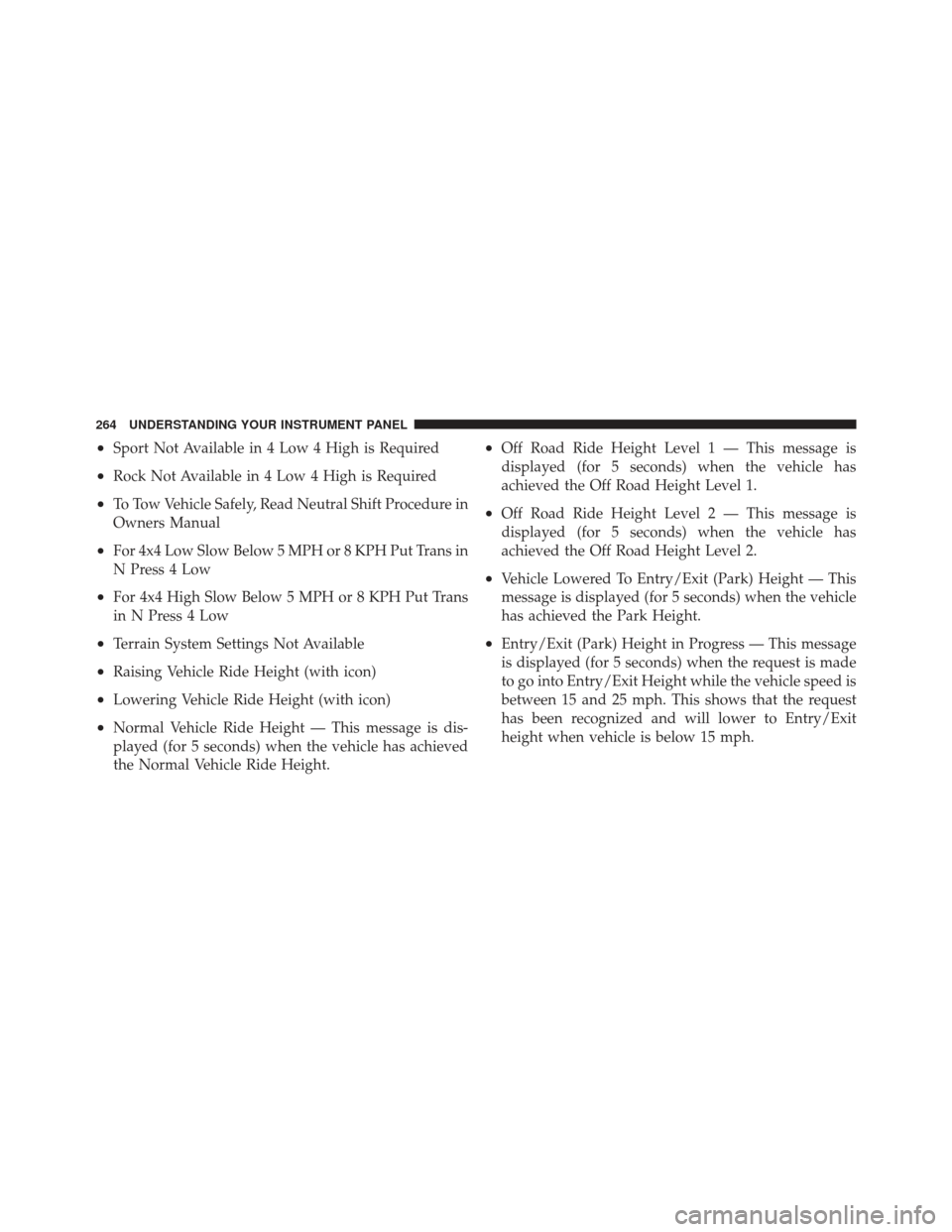
•Sport Not Available in 4 Low 4 High is Required
•Rock Not Available in 4 Low 4 High is Required
•To Tow Vehicle Safely, Read Neutral Shift Procedure in
Owners Manual
•For 4x4 Low Slow Below 5 MPH or 8 KPH Put Trans in
N Press 4 Low
•For 4x4 High Slow Below 5 MPH or 8 KPH Put Trans
in N Press 4 Low
•Terrain System Settings Not Available
•Raising Vehicle Ride Height (with icon)
•Lowering Vehicle Ride Height (with icon)
•Normal Vehicle Ride Height — This message is dis-
played (for 5 seconds) when the vehicle has achieved
the Normal Vehicle Ride Height.
•Off Road Ride Height Level 1 — This message is
displayed (for 5 seconds) when the vehicle has
achieved the Off Road Height Level 1.
•Off Road Ride Height Level 2 — This message is
displayed (for 5 seconds) when the vehicle has
achieved the Off Road Height Level 2.
•Vehicle Lowered To Entry/Exit (Park) Height — This
message is displayed (for 5 seconds) when the vehicle
has achieved the Park Height.
•Entry/Exit (Park) Height in Progress — This message
is displayed (for 5 seconds) when the request is made
to go into Entry/Exit Height while the vehicle speed is
between 15 and 25 mph. This shows that the request
has been recognized and will lower to Entry/Exit
height when vehicle is below 15 mph.
264 UNDERSTANDING YOUR INSTRUMENT PANEL
Page 272 of 587

vehicle is experiencing a problem with the charging
system. Obtain SERVICE IMMEDIATELY. See an autho-
rized dealer.
If jump starting is required, refer to “Jump Starting
Procedures” in “What To Do In Emergencies”.
•Electronic Throttle Control (ETC) LightThis light informs you of a problem with the
Electronic Throttle Control (ETC) system. The
light will come on when the ignition is first
turned ON and remain on briefly as a bulb
check. If the light does not come on during starting, have
the system checked by an authorized dealer.
If a problem is detected, the light will come on while the
engine is running. Cycle the ignition key when the
vehicle has completely stopped and the shift lever is
placed in the PARK position. The light should turn off. If the light remains lit with the engine running, your
vehicle will usually be drivable. However, see an autho-
rized dealer for service as soon as possible. If the light is
flashing when the engine is running, immediate service is
required and you may experience reduced performance,
an elevated/rough idle or engine stall and your vehicle
may require towing.
•Engine Temperature Warning Light
This light warns of an overheated engine condi-
tion. As temperatures rise and the gauge ap-
proaches H,this indicator will illuminate and a
single chime will sound after reaching a set threshold.
Further overheating will cause the temperature gauge to
pass H,the indicator will continuously flash and a
continuous chime will occur until the engine is allowed
to cool.
270 UNDERSTANDING YOUR INSTRUMENT PANEL
Page 273 of 587
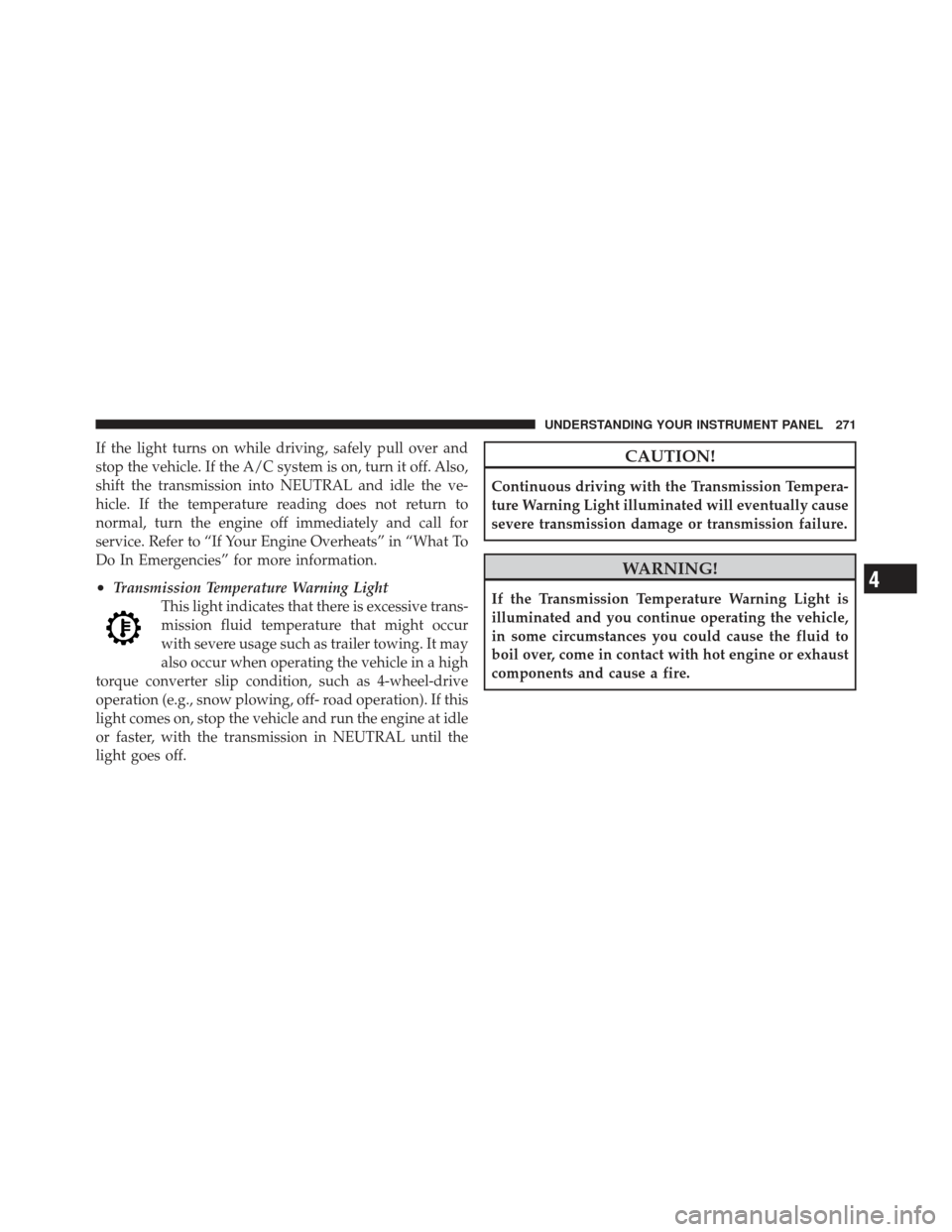
If the light turns on while driving, safely pull over and
stop the vehicle. If the A/C system is on, turn it off. Also,
shift the transmission into NEUTRAL and idle the ve-
hicle. If the temperature reading does not return to
normal, turn the engine off immediately and call for
service. Refer to “If Your Engine Overheats” in “What To
Do In Emergencies” for more information.
•Transmission Temperature Warning LightThis light indicates that there is excessive trans-
mission fluid temperature that might occur
with severe usage such as trailer towing. It may
also occur when operating the vehicle in a high
torque converter slip condition, such as 4-wheel-drive
operation (e.g., snow plowing, off- road operation). If this
light comes on, stop the vehicle and run the engine at idle
or faster, with the transmission in NEUTRAL until the
light goes off.
CAUTION!
Continuous driving with the Transmission Tempera-
ture Warning Light illuminated will eventually cause
severe transmission damage or transmission failure.
WARNING!
If the Transmission Temperature Warning Light is
illuminated and you continue operating the vehicle,
in some circumstances you could cause the fluid to
boil over, come in contact with hot engine or exhaust
components and cause a fire.
4
UNDERSTANDING YOUR INSTRUMENT PANEL 271
Page 327 of 587
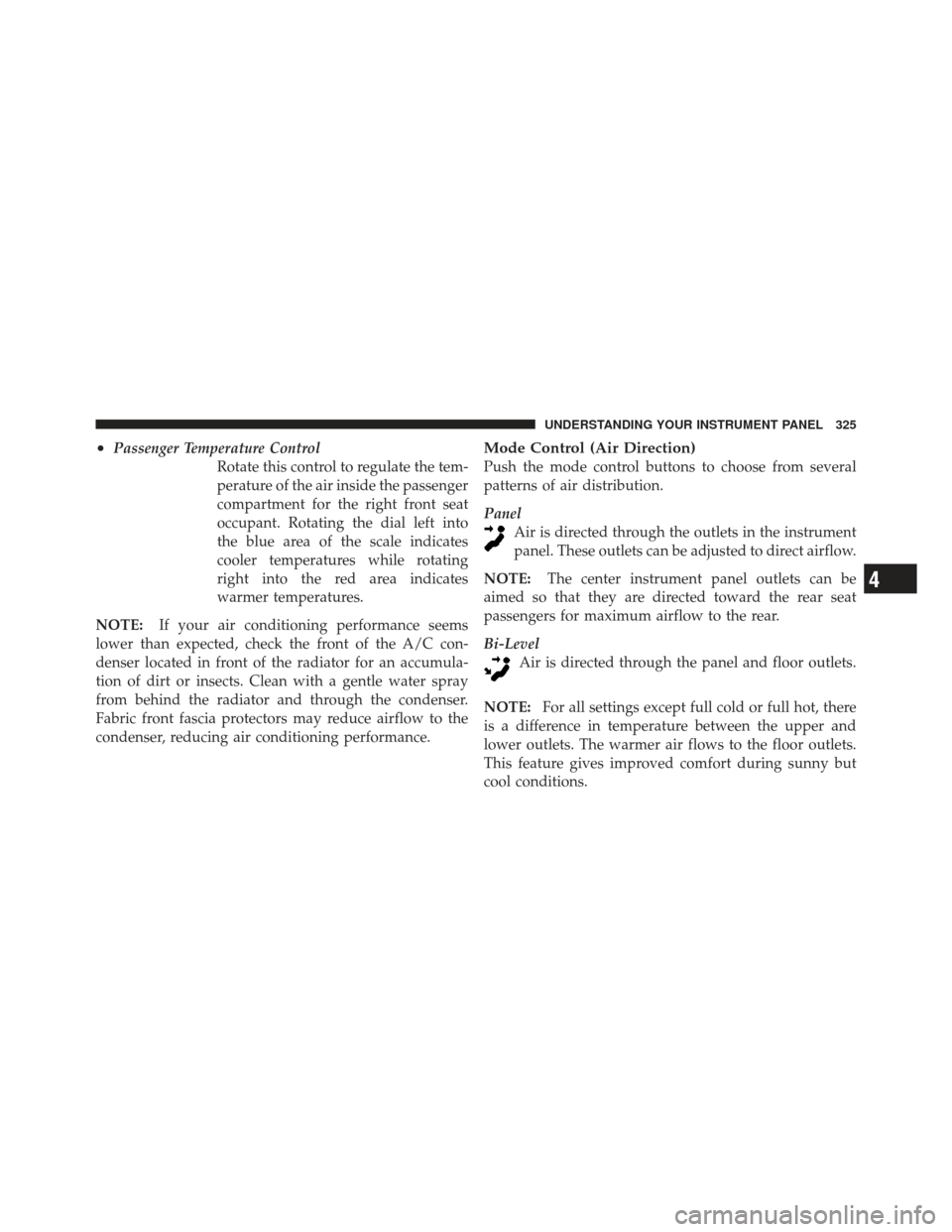
•Passenger Temperature ControlRotate this control to regulate the tem-
perature of the air inside the passenger
compartment for the right front seat
occupant. Rotating the dial left into
the blue area of the scale indicates
cooler temperatures while rotating
right into the red area indicates
warmer temperatures.
NOTE: If your air conditioning performance seems
lower than expected, check the front of the A/C con-
denser located in front of the radiator for an accumula-
tion of dirt or insects. Clean with a gentle water spray
from behind the radiator and through the condenser.
Fabric front fascia protectors may reduce airflow to the
condenser, reducing air conditioning performance.Mode Control (Air Direction)
Push the mode control buttons to choose from several
patterns of air distribution.
Panel Air is directed through the outlets in the instrument
panel. These outlets can be adjusted to direct airflow.
NOTE: The center instrument panel outlets can be
aimed so that they are directed toward the rear seat
passengers for maximum airflow to the rear.
Bi-Level Air is directed through the panel and floor outlets.
NOTE: For all settings except full cold or full hot, there
is a difference in temperature between the upper and
lower outlets. The warmer air flows to the floor outlets.
This feature gives improved comfort during sunny but
cool conditions.
4
UNDERSTANDING YOUR INSTRUMENT PANEL 325
Page 337 of 587
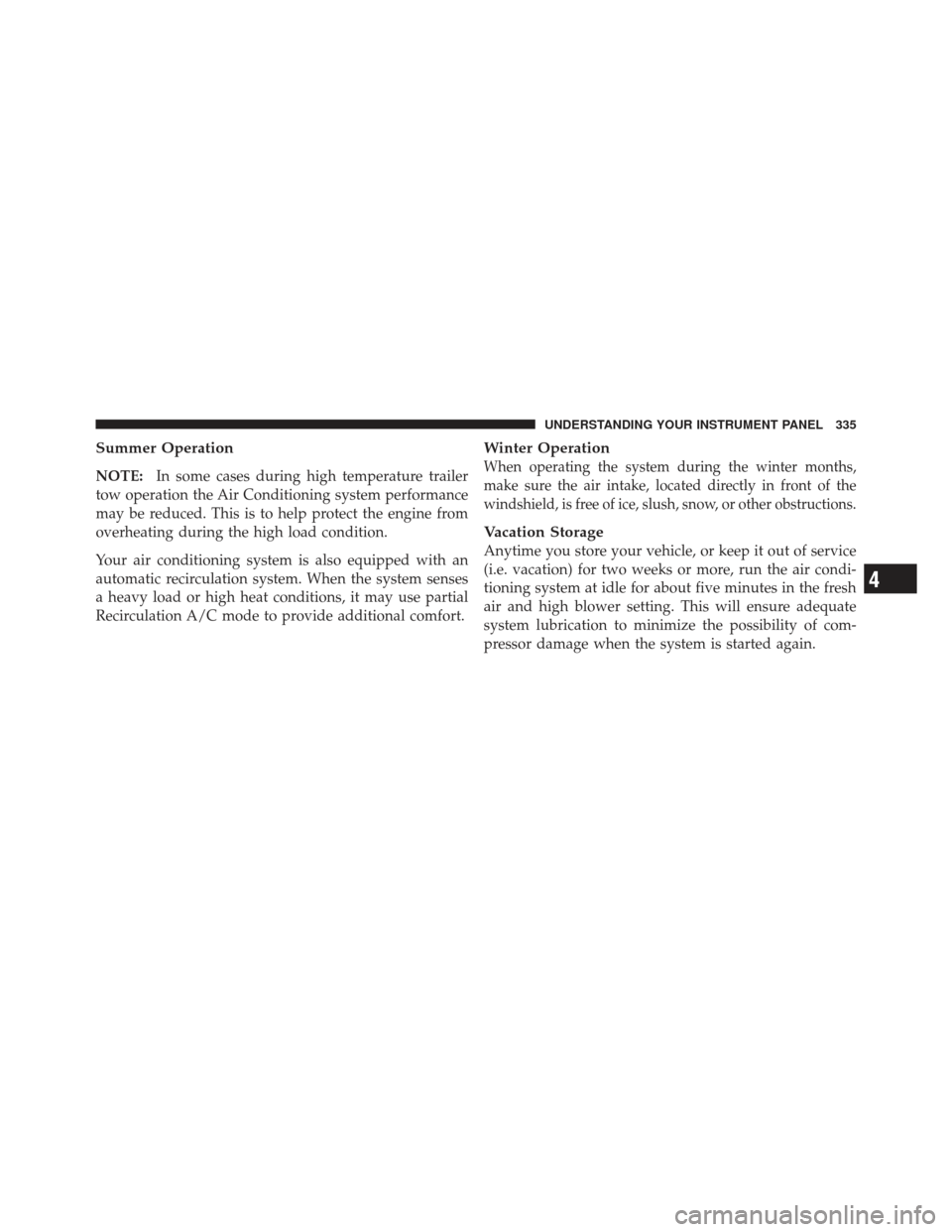
Summer Operation
NOTE:In some cases during high temperature trailer
tow operation the Air Conditioning system performance
may be reduced. This is to help protect the engine from
overheating during the high load condition.
Your air conditioning system is also equipped with an
automatic recirculation system. When the system senses
a heavy load or high heat conditions, it may use partial
Recirculation A/C mode to provide additional comfort.
Winter Operation
When operating the system during the winter months,
make sure the air intake, located directly in front of the
windshield, is free of ice, slush, snow, or other obstructions.
Vacation Storage
Anytime you store your vehicle, or keep it out of service
(i.e. vacation) for two weeks or more, run the air condi-
tioning system at idle for about five minutes in the fresh
air and high blower setting. This will ensure adequate
system lubrication to minimize the possibility of com-
pressor damage when the system is started again.
4
UNDERSTANDING YOUR INSTRUMENT PANEL 335
Page 343 of 587

▫Carbon Monoxide Warnings ............ 428
� Flexible Fuel (3.6L Engine Only) —
If Equipped .......................... 429
▫ E-85 General Information ............... 429
▫ Ethanol Fuel (E-85) ................... 430
▫ Fuel Requirements ................... 430
▫ Selection Of Engine Oil For Flexible Fuel
Vehicles (E-85) And Gasoline Vehicles ...... 431
▫ Starting ........................... 432
▫ Cruising Range ...................... 432
▫ Replacement Parts ................... 432
▫ Maintenance ........................ 432 �
Adding Fuel ......................... 433
▫ Fuel Filler Cap (Gas Cap) .............. 433
▫ Loose Fuel Filler Cap Message ........... 436
� Vehicle Loading ...................... 436
▫ Certification Label ................... 436
� Trailer Towing ........................ 438
▫ Common Towing Definitions ............ 439
▫ Trailer Hitch Classification .............. 443
▫ Trailer Towing Weights
(Maximum Trailer Weight Ratings) ........ 444
▫ Trailer And Tongue Weight ............. 445
▫ Towing Requirements ................. 446
▫ Towing Tips ........................ 451
5
STARTING AND OPERATING 341
Page 344 of 587
�Snow Plow .......................... 452
� Recreational Towing
(Behind Motorhome, Etc.) ................ 453
▫ Towing This Vehicle Behind
Another Vehicle ..................... 453
▫ Recreational Towing — Two-Wheel Drive
Models ........................... 454 ▫
Recreational Towing — Quadra-Trac I�
(Single-Speed Transfer Case) Four-Wheel
Drive Models ....................... 454
▫ Recreational Towing — Quadra–
Trac II� /Quadra–Drive� II Four-Wheel
Drive Models ....................... 455
342 STARTING AND OPERATING
Page 349 of 587
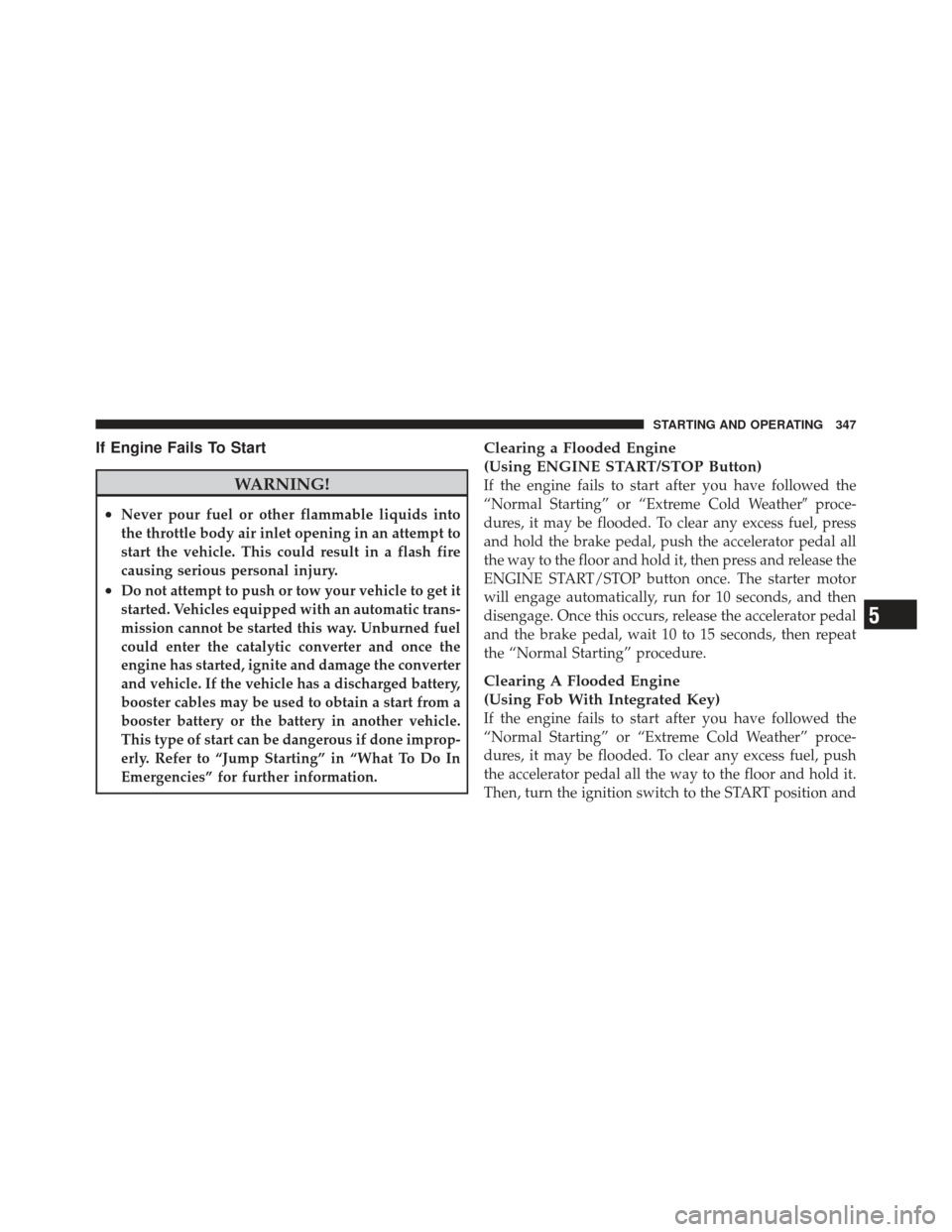
If Engine Fails To Start
WARNING!
•Never pour fuel or other flammable liquids into
the throttle body air inlet opening in an attempt to
start the vehicle. This could result in a flash fire
causing serious personal injury.
•Do not attempt to push or tow your vehicle to get it
started. Vehicles equipped with an automatic trans-
mission cannot be started this way. Unburned fuel
could enter the catalytic converter and once the
engine has started, ignite and damage the converter
and vehicle. If the vehicle has a discharged battery,
booster cables may be used to obtain a start from a
booster battery or the battery in another vehicle.
This type of start can be dangerous if done improp-
erly. Refer to “Jump Starting” in “What To Do In
Emergencies” for further information.
Clearing a Flooded Engine
(Using ENGINE START/STOP Button)
If the engine fails to start after you have followed the
“Normal Starting” or “Extreme Cold Weather�proce-
dures, it may be flooded. To clear any excess fuel, press
and hold the brake pedal, push the accelerator pedal all
the way to the floor and hold it, then press and release the
ENGINE START/STOP button once. The starter motor
will engage automatically, run for 10 seconds, and then
disengage. Once this occurs, release the accelerator pedal
and the brake pedal, wait 10 to 15 seconds, then repeat
the “Normal Starting” procedure.
Clearing A Flooded Engine
(Using Fob With Integrated Key)
If the engine fails to start after you have followed the
“Normal Starting” or “Extreme Cold Weather” proce-
dures, it may be flooded. To clear any excess fuel, push
the accelerator pedal all the way to the floor and hold it.
Then, turn the ignition switch to the START position and
5
STARTING AND OPERATING 347